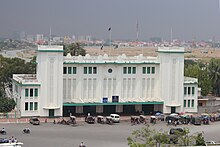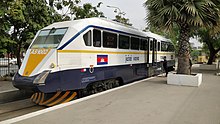Rail transport in Cambodia
The rail transport in Cambodia suffered from wars and general insecurity in the country. The infrastructure visibly rotted from the middle of the 20th to the beginning of the 21st century. Attempts to restore it did not pay off until 2015/16 with the restart of the Phnom Penh – Sihanoukville (southern line) with a length of 264 km and in 2018/19 with the Phnom Penh – Poipet (northern line) with a length of 386 km. From 2014 John Guiry was the director of the Royal Railway Cambodia .
history
The construction of the first railway line in Cambodia , the Northern Railway , was started by the colonial administration of French Indochina in 1929 and opened in sections until June 1, 1933 to Mongkol Borei. The extension to Poipet and the connection to the Thai Eastern Railway in Aranyaprathet did not take place until World War II , when these parts of the country were temporarily annexed by Thailand . After France handed over railway operations to Cambodia in 1952, the state railway was renamed Chemins de Fer Royaux du Cambodge (CRC) (Royal Cambodian Railway). Cross-border rail traffic to Thailand took place in the following decades when the political situation was favorable between neighboring countries; if this deteriorated, it was interrupted, and the tracks in the border area were even removed. On July 2, 1974, it was finally over, when the Khmer Rouge increasingly gained control of Cambodia .
The southern line as the second railway line in Cambodia was built between 1960 and 1969 by the Federal Republic of Germany, China and France as a new line after the dissolution of French Indochina in 1954 and the independence of Cambodia, the country no longer had a domestic overseas port. The route connects Phnom Penh with the purpose-built port of Sihanoukville on the Gulf of Thailand .
During the rule of the Khmer Rouge , railway operations in Cambodia were stopped, the railway infrastructure was destroyed or damaged, and the section of the northern railway between the Thai border and Sisophon was dismantled.
After the Khmer Rouge was driven out in 1979, the restoration of the southern and northern lines to Battambang began in the 1980s. In 1991, the northern line to Sisophon was put back into operation. In the following years, however, the railway operations on both routes fell into disrepair and were completely shut down for a long time. The southern railway line was not put back into operation until 2015 after extensive reconstruction work.
As of June 12, 2009, the government had the railway operation for 30 years as a concession to Toll (Cambodia) Co., Ltd. , which operates under the name Toll Royal Railway , is a joint venture between the Australian Toll Group and the Cambodian Royal Group . At the end of 2014, the Toll Group announced that it would sell its 55% stake and withdraw from the joint venture. The company is now 100% owned by the Royal Group and changed its name to Royal Railway of Cambodia (RRC) in 2015 .
Since April 2016, passenger trains have been running again on the Südbahn, at least on weekends and holidays. Freight trains run every working day, among other things, fuel is transported to Phnom Penh in six block trains per week.
In mid-2018, after almost a year of construction, an almost two-kilometer branch line to Phnom Penh Airport went into operation from the main track . The track was laid in the middle of the existing 105K road. A shuttle train runs between the airport and the main train station and covers the route in around 30 minutes at a top speed of 20 km / h. Old Chinese rolling stock that has been renewed is used for the operation. The acquisition of modern railcars is planned. In the first few months after commissioning, use was free of charge. According to the director, John Guiry, with a ticket price of two and a half dollars (10,000 Riel) 10 passengers per trip would be sufficient to cover the operating costs.
The renovation of the northern railway line was completed at the end of 2018 . Recommissioning is planned for 2019.
Web links
literature
- BR Whyte: The Railway Atlas of Thailand, Laos and Cambodia . White Lotus Co Ltd, Bangkok 2010, ISBN 978-974-480-157-9
Individual evidence
- ↑ a b c Manfred Rist: The airport train from Phnom Penh . In: Neue Zürcher Zeitung . No. 234 , October 9, 2018, p. 22 .
- ↑ Whyte, pp. 35, 37.
- ↑ Whyte, p. 161.
- ^ Homepage of the Toll Royal Railway ; Whyte, p. 164.
- ↑ Toll divests its stake in Cambodia railway. ( Memento of the original from April 20, 2016 in the Internet Archive ) Info: The archive link was inserted automatically and has not yet been checked. Please check the original and archive link according to the instructions and then remove this notice. Toll Group, December 22, 2014.
- ↑ Toll Group divests stake Cambodian railway. In: Railway Gazette , December 22, 2014.
- ↑ Passenger Train. Royal Railway Cambodia, May 6, 2016, accessed November 7, 2016 .
- ↑ News updated for February 2016. May 6, 2016, accessed November 7, 2016 .
- ↑ Northern section of Cambodian western rail line ready for test. Khmer Times, February 15, 2018.




